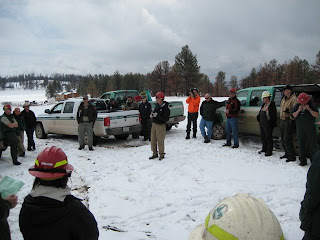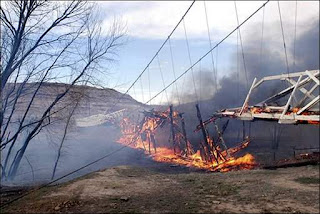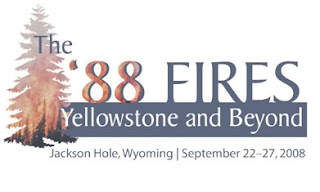It was a little surreal today standing in the snow trying to picture what a very intense fire was doing in that very spot 9 months ago. The 40 of us participating in a “Staff Ride” for the July, 2007, Alabaugh fire near Hot Springs, South Dakota, were recreating in our minds what two people entrapped by the fire were going through last summer.
(As usual, click on the photos to see larger versions.)
The all-day experience began with a couple of hours of classroom time, where we got some information about staff rides in general, and some basic information about the Alabaugh fire, including a portion of the video segment about the fire that is in this year’s wildland fire refresher. We wrote about this year’s refresher training HERE on March 23 where I modestly mentioned that some of my photos of the fire are being used in the training.
Then we spent most of the rest of the day in the field, walking in the very footsteps of the people who on July 7, 2007, were fighting a very complex, rapidly developing, wildland-urban interface fire. Many of those firefighters were with us out there today, telling us what they saw, what they were thinking, and giving us the opportunity to experience the fire through their perceptions–but while standing in 2″ of snow, rather than 100+ degree temperatures, 7% relative humidity, and strong shifting winds gusting out of thunderstorm cells.
 Al Stover, Initial Attack Incident Commander, showing us the point of origin. Photo by Bill Gabbert.
Al Stover, Initial Attack Incident Commander, showing us the point of origin. Photo by Bill Gabbert.
Two firefighters had to share one fire shelter, since one of them forgot his line gear, leaving it in his vehicle while he got out to direct a structure protection operation. Then he became engaged in the some firing, got entrapped, and lived to tell about it.
 This hard hat was blown off the head of one of the persons entrapped. It was left on the ground while he was sharing a fire shelter with another firefighter. Photo by Bill Gabbert
This hard hat was blown off the head of one of the persons entrapped. It was left on the ground while he was sharing a fire shelter with another firefighter. Photo by Bill GabbertAn interesting facet of the staff ride was that it served as the 8-hour annual wildland fire refresher that is now required by many agencies. And yes, we practiced getting into a fire shelter in 30 seconds….. with a twist. We all shared a shelter with one other person! WHAT? Yes, it’s true!








